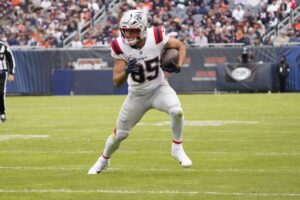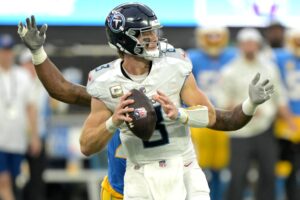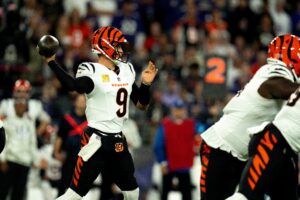The New Orleans Saints were flat-out dominant in their 47-10 win over the Buffalo Bills; scoring a franchise-record six rushing touchdowns, and holding the Bills to three points until late in the fourth quarter. However, it didn’t appear that such a blowout would be possible after running back LeSean McCoy broke loose for 36 yards on Buffalo’s opening drive, resulting in a field goal.
Heading into week 10, the Saints had given up an average of 4.7 yards per rush, but this problem hadn’t yet become a crisis since the Saints have been able to play with a lead in most of their games. After McCoy’s big run, it felt necessary for New Orleans to score on the next drive in order to put pressure on the Bills offense, and prevent McCoy from getting too hot and exploiting the Saints biggest weakness.
The Saints responded with a touchdown on a nine play, 75 yard drive which revealed their gameplan for the rest of the day. New Orleans went on to gain 482 total yards, and control the ball for over 41 minutes by using some of the same looks first seen on their opening possession. Here’s a breakdown of three significant plays from the Saints tone-setting initial drive.
New Orleans Saints Week 10 Film Analysis: First Offensive Drive
13-yard Reception by Michael Thomas, 10:58 Remaining in First Quarter
The Saints lined up with three wide receivers, but it looked more like a running formation with Willie Snead and Brandon Coleman stacked just outside tight end Michael Hoomanawanui on the left. Wide Receiver Michael Thomas was split out wide on the right side. Running back Mark Ingram darted forward as if he were preparing to take a handoff, and the offensive line and receivers to the left stepped forward for apparent run blocks. However, quarterback Drew Brees threw to Thomas immediately on a slant route instead of handing off to Ingram.
Rookie Bills cornerback Tre’Davious White was in soft zone coverage across from Thomas, and was a full seven yards away from the receiver when Brees released the ball. Presumably, one of the linebackers was supposed to be in coverage underneath to prevent this type of throw, but they were all distracted by a potential run. Thomas had plenty of room to pick up the first down, and a little extra before he was tackled. White continued to give Thomas a lot of cushion in coverage, and New Orleans exploited him on two more underneath throws on a drive in the second quarter.
Nine-Yard Run by Alvin Kamara, 10:29 Remaining in First Quarter
On the next play, Alvin Kamara received the first Saints handoff from another three receiver formation. This time, a pass looked more likely with Thomas and Coleman split out wide, and Snead in the slot on the left side. The Bills had most of their front-seven lined up on the strong side, and the Saints motioned tight end Coby Fleener left to take advantage of the undermanned side. The Bills must have thought this was a decoy because they didn’t shift their line, and the linebackers only reacted by taking a few steps to the weak side.
Rather predictably, there was a big hole between the left guard and tackle when Kamara took the handoff. Left guard Andrus Peat picked up an incoming linebacker and pushed him out of the hole. Kamara showed no hesitation as he hit the hole and broke a tackle. Thomas and Fleener both did a good job of finding defenders to block downfield, and it was nearly enough to get Kamara the first down.
Most of Kamara’s runs against Buffalo came from three receiver formations; exploiting a spread out Bills defense. Kamara also picked up six yards on a screen pass three plays later, and was targeted on several more screens throughout the game.
25-Yard Run by Ingram, 7:46 Remaining in First Quarter
On this fourth-and-one play, the Saints could have tried a 47-yard field goal, but clearly head coach Sean Payton wanted more from this drive. New Orleans lined up with three wide receivers again, but none were split out wide. Buffalo clearly expected the Saints to run it right at them, and had eight men in the box. However, they didn’t anticipate wide receiver Ted Ginn Jr. motioning into the backfield from the left side, just before the snap.
The linebacker on the weak side signaled for strong side linebacker Lorenzo Alexander to shift left to prepare for a run to the right, but this turned out to be a costly mistake. As Ginn ran right following the snap, Brees handed the ball to Ingram, who initially ran towards the left side of the line. Then Ingram cut right in the backfield, and ran precisely where Alexander would have been if he hadn’t been taken out of the play by right guard Larry Warford.
Ingram easily made it to the second level of the Bills defense as every other defender in the box had been faked out either by Ginn’s motion, or Ingram’s cutback. With that being said, the Saints had a great push from their interior offensive line, and may have picked up the first down even without Ginn’s motion. Ingram spun out of a tackle downfield, and made it to the Bills five-yard line. He ran for a touchdown two plays later.
The Saints motioned Ginn on running plays nine more times against Buffalo, and ironically, Ginn never once ran the ball. Each play resulted in positive yardage. The Saints did a great job of using Ginn’s motion in different ways so that the Bills defense reacted to the receiver each time. On this play Ginn ran right behind Brees, who faked a handoff to him before tossing it to Kamara, and New Orleans did so again here, but to the opposite side. One time they motioned Ginn behind a two-back set, and gave it to Ingram on a run up the middle, and here Ginn was moved behind the tight end before shifting into the backfield.
The Saints have long been known for being unpredictable in their passing game, and now they’re finding ways to deceive defenses with their rushing attack as they become more of a run-first offense.
Main Image:






